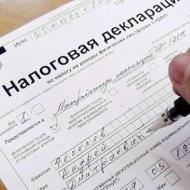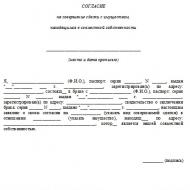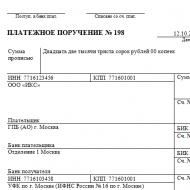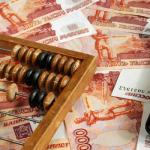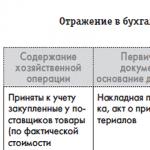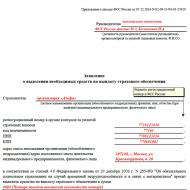
Economic theory, methodology of economic science, microeconomics. Subject and method of economic theory. The balance sheet method is used to analyze household cash income and expenses. Used in constructing simple deterministic economies
Economic theory studies economic relations and market organization of the economy. Economic theory studies the functioning national economy and organization of international economic relations.
Economic theory consists of 4 sections:
- General principles of economic theory
- Microeconomics
- Macroeconomics
- World economy
In the general section Basics of economic theory the market organization of the economy and the functioning of the market are studied: market subjects, functions and principles of market relations, market infrastructure, forms of ownership, etc.
In chapter microeconomics economic relations developing between individual economic entities (firms, enterprises, organizations) and households are studied.
Microeconomics is the primary link of economics. Its economic categories are: market demand, market supply, costs, profit, etc.
In chapter macroeconomics The activities of individual industries and the entire national economy of the country as a whole are studied. Here they study the decisions made by the government to manage the economy. Economic categories: aggregate demand, aggregate supply, inflation, unemployment, financial system, taxation, loans, banking system etc.
In chapter world economy explores global economic relationships between countries, blocks and groupings of countries, between financial and economic organizations and the world's largest banks.
International economic relations are studied through the prism of the international division of labor and international economic organization.
In the global economy, the movement of investment, capital and labor between countries is studied.
Economic theory uses its own tools and concepts:
- Economic categories - basic, key concepts used when conducting economic analysis, formulating conclusions, and explaining others economic categories. Examples: category of price, profit, costs.
- Economic laws are global, universal relationships and patterns that are cause-and-effect in nature and operate for a long time and invariably, regardless of the will and consciousness of people. For example: , cost.
- Economic principles - features of the manifestation of economic laws. Example: principles of market relations - private property, personal interest, competition and freedom of choice.
- Economic factors (reasons for changes) - features of the manifestation of economic categories. Example: factors influencing exchange rate— the level of inflation in the country, the rate of economic growth in the country, the size gold and foreign exchange reserves, GDP size per capita.
There are two groups of problems in economics:
- The problem of rarity - Natural resources limited and even rare. For example: oil reserves should last for 50 years, gas reserves - 60, tungsten and molybdenum - no longer available.
- The problem of choosing effective ways to use limited resources and the use of artificial and composite materials, resource- and energy-saving technologies.
Thus, the subject of the study of economic theory is: the study of issues of effective use of limited resources to satisfy the unlimited needs of people.
Methods of economic theory
Economic theory uses the following research methods:
- analysis
- synthesis
- systematization of observations
- method of induction and deduction
- logical and historical approach
- method of scientific abstraction
- banking method
- statistical method
- economic-mathematical method
Thus, the methods of economic theory are a set of techniques and methods by which economic relations are studied.
Economic laws- stable, significant cause-and-effect, recurring relationships between economic phenomena and processes. In other words, economic laws are essentially a manifestation of stable relationships between people that develop in the process of production, distribution, exchange and consumption, which at the same time manifest themselves as interests.
Basic economic laws
· Law of demand
· Law of general macroeconomic equilibrium
· Law of private economic equilibrium
Law of the productive power of labor
· Law of supply
Law of competition
Law of value
· Laws money circulation
· Laws of economic growth
Law of production efficiency
· Law of proportionality
Law of accumulation
Functions of economic laws
Economic laws perform certain functions that are decisively related to social development. Moreover, the functions of each of the laws are specific, just as the stable, significant and strong connections between economic phenomena that they express are specific.
At the same time, the entire set of economic laws introduces the economic life of society developing within the framework of each given economic system, in a certain objectively determined direction, what is its main function.
Study methods used in economic science.
Methodology economic science
The methodology of economic theory is the science of studying methods economic life, economic phenomena. The methodology is designed to solve the main question: with the help of what scientific methods, methods of understanding reality, economic theory achieves true illumination of the functioning and further development of a particular economic system.
In the methodology of economic theory, several main approaches can be distinguished:
1) subjective approach - the object of economic analysis is the behavior of an economic subject, the main category in this approach is need, utility. Economics becomes the theory of choice made by an economic entity from various options;
2) the neopositive-empirical approach is based on more
careful study of phenomena and their assessments. At the forefront of one hundred
a technical research apparatus is developing, which from a tool
turns into an object of knowledge (mathematical apparatus, eco
nometrics, cybernetics, etc.), and the result of the research is highly
various kinds of empirical models become dull;
The rationalistic approach aims to study the economic system as a whole, the economic laws governing this system. The main attention in this approach is paid to cost, price, economic laws;
The dialectical-materialistic approach is considered the only correct solution to scientific problems on the basis of an objective analysis that characterizes the internal connections of phenomena that exist in reality and in their development. Economic processes and phenomena constantly arise, develop and are destroyed, that is, they are in constant motion - and this is dialectics.
Methodology should not be confused with methods. A method is a tool, a set of research techniques in science and their reproduction in a system of economic categories and laws.
Economic theory uses a wide range of methods of scientific knowledge. Here are some of them:
Method of scientific abstraction(from the Latin “abstractio” - abstraction), when the researcher is distracted from the secondary aspects of phenomena in order to identify what is essentially and constantly repeated in them. This is how such general concepts as production, needs, distribution, exchange, etc. arise.
Analysis- this is the mental division of the phenomenon being studied into its component parts and sides and the study of each of these parts separately.
Synthesis- reconstruction of a single holistic picture.
Induction method- transition from the study of individual facts to general provisions and conclusions.
Deduction method makes it possible to move from the most general conclusions to relatively specific ones.
Historical method- is a study of economic processes And phenomena in the sequence in which they arose and developed in life itself. This method has a drawback - the abundance of descriptive material and particular historical details can complicate the study of the economy.
Economic and mathematical modeling allows you to formally determine the causes of changes in economic phenomena, the patterns of these changes, their consequences, opportunities and costs of influencing the course of changes, and also makes forecasting realistic economic processes.
Oligopoly and its signs.
Oligopoly. In an oligopolistic market, several large firms (from three to five) compete with each other, and the entry of new firms into this market is difficult. Products produced by firms can be either homogeneous or differentiated. Homogeneity prevails in markets for raw materials and semi-finished products, differentiation prevails in markets for consumer goods (for example, cars).
The existence of an oligopoly is associated with restrictions on entry into a given market. One of them is the need for significant capital investment to create an enterprise in connection with the large-scale production of oligopolistic firms.
Oligopolistic producers know that if they lower prices, their competitors will do the same, resulting in a fall in revenue. Therefore, instead of price competition, which is effective in conditions of perfect competition, oligopolists use non-price methods of struggle: technical superiority, quality and reliability of the product, sales methods, the nature of the services provided and guarantees, differentiation of payment terms, advertising, economic espionage.
A characteristic feature of an oligopolistic market is the dependence of the behavior of each firm on the reaction and behavior of competitors. Large size and significant capital of firms are extremely immobile in the market, and under these conditions, the greatest benefits are promised by collusion between olipolists in order to maintain prices and maximize profits. Manufacturers agree on cooperation and enter into an agreement to divide the market - a cartel agreement.
A cartel is an agreement between several enterprises that establishes for all participants the volume of production, prices for goods, conditions for hiring labor, exchange of patents, delimitation of sales markets and the share (quota) of each participant in the total volume of production and sales. Its goal is to increase prices (above the competitive level), but not to limit the production and supply and marketing activities of participants.
A classic example of the formation and existence of a cartel agreement to this day is the Organization of Petroleum Exporting Countries (OPEC), which at different periods of its history controlled from 25% to 60% of the oil production of industrial countries.
Classification of enterprises.
An enterprise is an independent economic entity created to produce products, perform work and provide services to meet public needs and make a profit.
Enterprises can be classified according to various quantitative and qualitative parameters. The main quantitative parameters are the number of employees and annual capital turnover.
In accordance with the criterion of the number of employees, the following are distinguished:
Small enterprises, or small businesses;
Medium enterprises, or medium business;
Large enterprises, or big business.
Among the qualitative parameters for classifying enterprises are:
Type of ownership (private or public);
The nature and content of the activity;
Volume of product range;
Ways and methods of management competition;
Method of joining various union associations;
Organizational and legal forms of entrepreneurial activity.
BY FORMS OF OWNERSHIP they distinguish: state, collective, individual (family), private, enterprises of public organizations, municipal enterprises and enterprises of mixed forms of ownership, rental.
The largest share is made up of state-owned enterprises.
State the enterprise is established by state governing bodies, is legal entity, has its own name indicating the organizational and legal form of the enterprise.
A state enterprise has a higher body (ministry, state committee) to which it is accountable and from which it receives an order or plan.
Private- an enterprise owned by a citizen on the right of ownership or members of his family on the right of common shared ownership, unless otherwise provided by the agreement between them.
BY SIZE, enterprises are divided into small, medium and large (depending on the number of employees, and therefore on the size of production activity). The standards for classifying an enterprise into one category or another are different in different countries.
Theory economic cycles
The origin of the theory of cycles and crises can be dated back to the beginning of the 19th century. This problem was highlighted in the works of K. Rodbertus and T. Malthus.
In our time, the idea of looking at the cycle as a single process, successively passing through phases of crises and upswings, and not simply as a random sequence of crises that interrupt the course of reproduction from time to time, has taken a predominant place. The subject of the study is the entire cycle, and not its individual phases.
Currently, 1380 types of business cycle have been identified.
Theories that study cycles based on the time they occur can be divided into three groups, and, accordingly, three types of cycle can be defined:
“Inventory cycle”- lasts 2-3 years.
“The Construction Cycle”- lasts 15-20 years.
“Long waves” - last 40-60 years.
Each of the theories looks in depth, each of them tries to find the reasons for the constant deviation of the economic system from the state of equilibrium. Many reasons for cyclical fluctuations have been put forward, from monetary expansion and the theory of innovation to the theory linking fluctuations in business activity to solar activity.
Cyclicity as an economic pattern is denied by many economists, for example, Nobel Prize laureates P. Samuelson, author of the first textbook “Economics”, V. Leontiev, many domestic scientists
Cyclicity is a general form of movement of national economies and the world economy as a whole. It expresses the uneven functioning of various elements of the national economy, the change of revolutionary and evolutionary stages of its development, and economic progress. Finally, cyclicality is the most important factor in economic dynamics, one of the determinants of macroeconomic equilibrium. Due to the complex, intersecting trends of various components of cyclicity, it is often extremely difficult to identify individual cycles. Most characteristic cyclicality - movement - occurs not in a circle, but in a spiral. Therefore, cyclicality is a form of progressive development. Each cycle has its own phases and its own duration. The characteristics of the phases are unique in their specific indicators. A specific cycle or phase has no twins. They are original both in historical and regional aspects.
Cyclicity is a movement from one macroeconomic equilibrium on the scale of at least the national economy to another. In fact, this is one of the ways to self-regulate a market economy, including changing it sectoral structure. At the same time, cyclicity is very sensitive to state influence on the national economy and the world economy as a whole.
Subject of economic theory. Microeconomics and macroeconomics.
Economic theory belongs to the category of social sciences, since production and market processes are carried out through social relations between people.
Economic theory studies social relations between people in the process of using limited resources in order to maximize satisfaction of unlimited individual and social needs, that is, production (economic) relations between people in the process of production, distribution, exchange and consumption of material goods.
The main task of economic theory is to provide not just a description of economic phenomena, but to show their interrelation and interdependence, that is, to reveal a system of economic phenomena, processes and laws. This is how it differs from specific economic disciplines.
Economic theory is the methodological foundation of a whole complex of sciences: sectoral (economics of industry, transport, construction, etc.); functional (finance, credit, marketing, management, forecasting, etc.); intersectoral (economic geography, demography, statistics, etc.).
Economic theory is not a set of rules about how to become rich. It does not provide ready-made answers to all problems. This is just a tool, a way of understanding economic reality. Mastery of this tool and knowledge of the basics of economic theory can help everyone do right choice in many life situations.
There are two levels of the economy - “macro level” and “micro level”.
Macroeconomics covers National economy in general, this is the sphere of general economic processes in which society appears as a set of firms and households interacting under the “supervision” of the state. At the center of macroanalysis is the relationship between aggregate values, such as gross national product, national income, total costs, etc.
Microeconomics is the sphere of functioning of the basic economic unit - the firm and the household. The market nature of microeconomics is that within its boundaries any type of activity acts as a source of income.
Let us highlight the following main differences between micro- and macroeconomics.
First: if microeconomics tends more toward stability and balance, then macroeconomics tends toward dynamics and growth.
The second difference between these two levels is that microeconomics is subject to the principle of market expediency, while macroeconomics is subject to the principle of social effect.
The third difference is that in microeconomics there are only two subjects (firm and household), but in macroeconomics the state fully joins them.
Over the centuries, the subject of economic science was refined and changed: until the 17th century. economics studied the characteristics of the household, then A. Montchretien defined it as the science of social economy (political economy). For many years, its subject was called the wealth of nations.
In the Marxist understanding, political economy is a science that studies the system of economic (production) relations that develop between people in the process of production, distribution, exchange and consumption of material goods, in conjunction with the productive forces of society.
Many modern textbooks consider the economic behavior of people as the subject of economic theory.
Synthesizing the ideas of various scientific schools and scientists over a number of centuries, subject of economic theory can be considered a system of economic (production) relations in unity with the wealth and limited resources, their effective use. This science studies human behavior - both as a producer and as a consumer.
Modern economic theory is the top of a multi-layered pyramid (system) of economic knowledge accumulated by humanity over the past 400 years. And economic science arose in Ancient Greece, first identified by Xenophon (430-355 BC) as “economy” in combination with “polis” - the state, i.e. the science of national (social) economy. The first stage of the emergence of economic theory covers the era of slave-owning and feudal society, i.e. reflects the views of the pre-market era with the predominance of subsistence farming.
In the 16th century, after the great geographical discoveries, commodity-money relations began to develop rapidly. The systematization of economic knowledge began. Mercantilism emerged as the first system of economic knowledge and the second stage in the development of economic theory. During the period of the emergence of capitalism (in the 17th century), the French economist Antoine de Montchretien called economics “political economy” (“Treatise political economy", 1615). This is how an independent science arose - political economy.
The third stage of its formation as an independent science is associated with the emergence of the school of physiocrats in the middle of the 18th century. (F. Quesnay, A. Turgot), who (unlike the mercantilists) placed not trade, but the production of goods and services at the center of economic science.
The fourth stage - development classical school political economy, which arose in the last third of the 18th century. (A. Smith) and received its highest development in the 19th century. (D. Ricardo, K. Marx). Its main provisions remain of fundamental importance to this day, i.e. are developed and enriched in modern scientific schools, which arose from classicism and its criticism over the course of 200 years.
The main directions and schools of modern economic theory (XX-XXI centuries) are:
Marginalism is the first and leading direction (scientific school) of neoclassical economic theory. The first marginalist revolution in economic theory occurred in the 70s. XIX century (W. Jevons, K. Menger, F. Wieser, E. Böhm-Bawerk). Its core is the theory of “marginal utility” of a product, designed to replace the classical theory labor cost goods.
Neoclassicism - developed in the 90s. XIX century as a result of the second stage of the marginalist revolution and reached its peak in the first third of the 20th century. in the works of A. Marshall and J. Clark. The functional analysis of production factors and the theory of factor income, pricing, as well as the use of economic and mathematical methods of analysis.
Neoliberalism emerged in the 1930s. XX century and remains one of the most influential areas of economic theory (J. Schumpeger, W. Eucken, A. Erhard, L. Mises, A. Schwartz, etc.). On turn of XX-XXI centuries The Chicago school of neoliberalism or monetarism (M. Friedman) gained great influence in theory and practice. Monetarism was the basis for radical economic reform during the transition to a market economy.
Keynesianism emerged in the 1930s. XX century in contrast to neoclassicism influenced by the world economic crisis 1929-1933 This theoretical school considers economic stability impossible without government intervention in the economy. Neo-Keynesianism was revived in the 70s. influenced by the new wave economic regulation economic growth.
institutionalism, which arose at the end of the 19th century. as an alternative to neoclassicism, it is constantly developing and enriching to the present day. This theoretical school placed man at the center of economics and believes that economic theory should study not only economic relations, but all conditions and factors influencing economic life - social, legal, psychological, political. Great importance is attached to the economic behavior of people, as well as social guarantees of economic stability.
Consequently, modern economic theory develops on the basis of pluralism economic schools and views reflecting different aspects, cross-sections of economic relations and all economic life.
Complexity and multi-layered nature economic life due to the presence of a large number of related industries economic knowledge, and, therefore, special economic sciences. These sciences, which study individual elements, structure, direct and reverse connections of economic reality, have developed into a system of economic sciences.
The methodological and theoretical basis of this system is economic theory. Performing a methodological function, economic theory also has its own subject of research - the essence and character economic activity an individual subject and their entirety at the level of the national economy.
To economic entities in market economy include firms and enterprises, the state, various funds, associations, households (family) and the individual. Their activities form economic phenomena and processes. The cause-and-effect relationships between economic phenomena in the process of their development are called economic laws. They are used by an economic entity to achieve certain results.
The functional activities of economic entities are aimed at solving three main problems of reproduction.
1. What to produce, in what quantity, of what quality and in what range.
2. How to produce, what costs to bear, using what resources, using what technologies, with the participation of what economic entities.
3. For whom to produce, what exactly will determine the structure of social and industrial consumers and relationships with them.
All three issues shape the relationships between economic actors in the spheres of production, distribution, exchange and consumption.
The method of analysis is a way of cognition, a path of research. When studying economic theory, a general philosophical method of understanding the world is used - dialectics, the foundations of which were laid by the ancient Greeks and which was brilliantly developed into a scientific system by the German philosopher G. Hegel. Dialectics examines phenomena in constant development, in their interrelation and interaction, penetrates into the essence of processes and phenomena, and cognizes the causes and sources of development.
The following stages of economic research are distinguished.
1. Gathering facts to study the problem.
2. Generalization of the results, i.e. establishment of economic principles. Deriving generalizations from facts is called economic analysis.
The method of induction is used here - inference from the particular to the general. For example, let's notice the connection between price and demand for a particular product. The generalization here is the law of demand. The method of deduction is inference from the general to the specific. Based on the derived law of demand, it can be assumed that for other goods there is a similar Feedback between price and demand.
At the last stage general principles economic behavior can be used to develop economic policy.
Often used in generalizations forecasting method. Modeling is used to make forecasts. Economic model is a mathematical expression based on economic theory. You can use models of your firm and a competitor's firm to predict changes in the competitor's output under the influence of your own firm's output.
Method of scientific abstraction- i.e. abstraction from everything private, random, short-term in determining typical, characteristic features.
Positive and normative analyzes play a leading role in economic research.
Positive analysis involves explaining and predicting phenomena in the economy. It is not associated with subjective value judgments and is based on what is and can be. Most positive statements are not controversial. For example, a positive statement is: “if a product is taxed, its price rises” or “an increase in income tax leads to a decrease in the purchasing price of the population, therefore, demand decreases, prices do not rise.”
Regulatory analysis is built on the value judgments of individuals and is based on what should be. It involves recipes for action and is applicable, as a rule, at the level of justification for economic policy. For example, the statement “to reduce inflation it is necessary to increase income tax“is normative, because other economists may believe that income taxes cannot be increased, since this reduces the incomes of people, which are already low in Russia. Thus, there is almost always controversy associated with the normative approach in economics.
Finally, the concept is often encountered opportunity cost. The cost of any good or service is determined by the number of other goods or services (the sum of their values) that must be sacrificed in order to obtain this good or service. For example, the opportunity cost of building a new stadium is the price of other goods and services, the production of which, figuratively speaking, is sacrificed for the construction of this stadium.
Economic theory as a science about the development of economic relations between people affects to varying degrees all aspects of the national and world economy. Therefore, it is closely connected with all other economic sciences, enriches and develops together with them in unified system economic knowledge.
Economic theory is the methodological and theoretical basis of all industrial, functional and information-analytical sciences. The latter learn and study economic relations, interrelations and features of the manifestation of economic laws in certain sectors of the economy (industry, Agriculture, construction, agro-industrial complex, etc.), as well as their reflection in financial, credit and other areas.
As the economy develops and scientific knowledge accumulates, differentiation and integration of economic sciences occurs. Sectoral and functional sciences related to economics appear: economic sociology, economic history, economic informatics, environmental economics, marketing, banking, stock exchange, etc. Consequently, the system of economic sciences is constantly enriched and developed.
Economic theory occupies a leading position in the system of economic sciences and performs the following functions:
Cognitive or theoretical function - to cognize, study, explain the processes and phenomena of economic life, reveal their inner essence and relationships;
Methodological function - economic theory constitutes the theoretical basis of the entire system of economic sciences, each of which has its own theoretical provisions based on the principles of general economic theory;
Worldview function - economic theory, along with other economic sciences, contributes to the formation of a scientific worldview adequate to a civilized market economy;
Prognostic - a comprehensive alternative assessment, scientifically based prediction of economic and other consequences of business decisions made in order to strengthen economic security countries.
Society always needs to make decisions about which goods and services should be produced and which should not be produced, i.e. Economics is constantly faced with the problem of choice. In Fig. 2.1 the production possibilities curve shows the maximum possible output with full use of given resources and technologies.
The amount of resources used is constant, and production is carried out efficiently. Then the production possibilities frontier will look like the AB curve. (example "> A units of PT, or B units of IT, or can be located at any point on the production possibilities curve AB. On this boundary at each point, society will produce the maximum possible amount of output given the given resources. In reality, one option is chosen (point on direct AB), which depends on many factors - economic, political, social, etc.
If society wants to produce more investment and consumer goods (point M outside the production possibilities curve), then the available resources will not be enough and production will be impossible. Increase in output of both types of goods with economic growth will become possible with an increase in the economic potential of the country (scientific and technological progress, new mineral deposits, quality of labor and management, etc.).
Any point inside the production possibilities curve indicates underemployment of resources, their inefficient use.
At the same time, society usually has reserves on hand, which allows, in an extreme situation, to sharply increase the output of one product without reducing the production of another. The country's economy often underutilizes its economic potential: unemployment, ineffective management, and bankruptcies of enterprises.
The quantity of a good that must be given up in order to obtain an additional quantity of another good is called implied economic costs of this product, i.e. We are again faced with the concept of opportunity cost. Here it is necessary to distinguish between the opportunity costs of producing an additional unit of goods and the total opportunity costs. The production of additional units of one good entails the sacrifice of ever-increasing quantities of another good. This is the essence of the law of increasing opportunity costs (Fig. 2.2).
On this graph, the production of each additional unit of PT will require an increasing reduction in investment goods. This explains the upward concavity of the production possibilities curve.
1. What is the subject of study of economic theory?
2. Name the functions of economic theory.
3. Name three fundamental questions of economic theory. .
4. Define the general method of analyzing economic processes.
5. What is the essence of the methods of induction and deduction?
6. What are positive and normative analyses?
7. Draw a production possibilities curve.
8. Indicate the place of economic theory in the system of economic knowledge.
If the subject of science is characterized by What she studies, then the method - How this is being investigated. The reality of the results and the correctness of the conclusions drawn depend on the correctly adopted method.
The term “method” comes from the Greek word and translated means “way”, “path”. Method- this is a set of techniques, methods, principles with the help of which ways to achieve a goal are determined.
The doctrine of methods, the theoretical justification of the methods of cognition used in science is usually called methodology. Literally, the term “methodology” means the study of methods of cognition.
Currently, all the variety of methods for studying economic phenomena and processes is usually combined into the following groups:
- 1) general philosophical;
- 2) general scientific;
- 3) private scientific (special).
General philosophical methods serve as the basis on which economic science develops. Historical experience has given rise to a variety of economic approaches to the study economic activity people, various scientific schools, which were based on different philosophical ideological foundations, such as metaphysics, dialectics, materialism.
Metaphysics literally translated as what comes after physics. This term denotes a part of philosophical teaching
Aristotle, exploring the highest, inaccessible to the senses, only speculatively comprehended and unchangeable principles of everything that exists in the world.
Dialectics is the science of the universal laws of development of nature, society, man and his thinking. It requires the study of reality in the interrelation of phenomena and their constant change and development.
Materialism is a philosophical direction that proceeds from the fact that the world is material and exists objectively, i.e. outside and independent of human consciousness; matter is primary, not created by anyone and exists forever. Consciousness, thinking is a property of matter. The knowability of the world and its laws is affirmed.
General scientific methods are methods that are used in all or many areas of scientific knowledge. Among them it is customary to distinguish: historical, logical and the method of scientific abstraction.
Historical The method requires that economic phenomena be studied not just in development, but taking into account the specific conditions of existence of individual peoples, countries, regions, including taking into account historical traditions, cultural characteristics, and customs.
Logical The method is abstract and theoretical and is based on the use of techniques such as analysis and synthesis, induction and deduction.
Analysis- This is the mental division of the phenomenon being studied into its component parts and the study of each of these parts separately. By synthesis economic theory recreates a single holistic picture. Induction and deduction are widely used. Through induction(guidance) ensures a transition from the study of individual facts to general provisions and conclusions. Deduction(derivation) makes it possible to move from general conclusions to specific ones.
Analysis and synthesis, induction and deduction are applied in unity by economic theory. Their combination provides a systematic, integrated approach to complex (multi-element) phenomena of economic life.
It is especially necessary to pay attention to one of the key methods used in economic theory - this method of scientific abstraction(from lat. abstractio- distraction). The researcher abstracts from the minor aspects of phenomena in order to identify what is essential and constantly repeated in them. This is how general concepts arise: production, needs, distribution, exchange, etc.
Historical and logical methods occupy an important place in the study of economic phenomena and processes. They do not oppose each other, but are applied in unity, since the starting point of historical research coincides, in general, with the starting point of logical research. However, the logical (theoretical) study of economic phenomena and processes is not a mirror reflection of the historical process. In the specific conditions of a particular country, economic phenomena may arise that are not obligatory for the prevailing economic system. If they actually (historically) take place, then they can be ignored in theoretical analysis. We can take our minds off them. A historian cannot ignore this kind of phenomenon. He must describe them.
Using the historical method, economics studies economic processes and phenomena in the sequence in which they arose, developed, and were replaced by one another in life itself. This approach allows us to concretely and clearly present the features of various economic systems.
The historical method shows that in nature and society development comes from simple to complex. In relation to the subject of economics, this means that in the entire set of economic phenomena and processes it is necessary to highlight first of all the simplest ones, those that arise earlier than others and form the basis for the emergence of more complex ones. For example, in market analysis this is an economic phenomenon such as the exchange of goods.
Private scientific methods represent the use of economic theory of scientific achievements of technical, natural, and related social sciences.
Let's look at some of them.
Economic processes and phenomena are characterized by qualitative and quantitative certainty. Therefore, economic theory widely uses mathematical and statistical techniques and research tools that allow us to identify the quantitative side of processes and phenomena of economic life, their transition to a new quality. In this case, computer technology is widely used. Plays a special role here method of economic and mathematical modeling. This method, being one of the systematic research methods, allows us to formally determine the causes of changes in economic phenomena, the patterns of these changes, their consequences, opportunities and costs of influence, and also makes forecasting economic processes realistic. Using this method, economic models are created.
Economic model - This is a formalized description of an economic process or phenomenon, the structure of which is determined by its objective properties and the subjective target nature of the study.
In connection with the construction of models, it is important to note the role functional analysis in economic theory.
Functions - these are variable quantities that depend on other variable quantities.
Functions occur in our daily lives and we most often do not realize it. They take place in technology, physics, geometry, chemistry, economics, etc. In relation to economics, for example, we can note the functional relationship between price and demand. Demand depends on price. If the price of a product increases, the quantity demanded for it, other things being equal, decreases. In this case, price is an independent variable, or argument, and demand is a dependent variable, or function. Thus, we can briefly say that demand is a function of price.
Economic-mathematical modeling as a method of economic theory became widespread in the 20th century. However, the element of subjectivity in the construction economic models sometimes leads to mistakes. Nobel Prize winner, French economist Maurice Allais wrote in 1989 that for 40 years economic science has been developing in the wrong direction: towards completely artificial and divorced from life mathematical models with a predominance of mathematical formalism, which is, in fact, a big step back.
Most models and principles of economic theory can be expressed graphically, in the form of mathematical equations, so when studying economic theory it is important to know mathematics and be able to draw up and read graphs.
it is a representation of the relationship between two or more variables.
Rice. 1.5.
For example, in Fig. 1.5a shows the reverse linear dependence(demand curve - as the price decreases, the quantity demanded for a product increases), and in Fig. 1.56 - direct linear relationship (supply curve - as the price increases, the volume of supply of the product increases).
Within the framework of the graphical approach, they are widely used diagrams- drawings showing the relationship between indicators. They can be circular, columnar, etc. (Fig. 1.6).

Rice. 1.6.
When studying the economic life of people, their groups and the entire society, economic experiments are possible, reasonable and necessary, although it is not always possible to foresee all the probable results of these experiments.
Economic experiment- is an artificial reproduction of an economic phenomenon or process with the aim of studying it under the most favorable conditions and further practical application. Conscious mass economic experimentation at the micro level is associated with the activities of the English utopian socialist Robert Owen (1771-1858), French socialist Pierre Joseph Proudhon (1809-1865), American researcher and practical manager Frederick Winslow Taylor (1856-1915), industrialist , the owner of the automobile plant Henry Ford (1863-1947) and the founder of the school of “human relations” Elton Mayo (1880-1945), and at the macro level - with the names of John Maynard Keynes and Milton Friedman. Large-scale experiments at the macro level were also carried out in the USSR.
Recently, something new to economic science has been highlighted separately. synergistic method. The term "synergetics" comes from the Greek word synergetikos and means the interaction effect various systems, capable of self-organization and self-regulation. Synergetics brings new visions of the problem to economic problems. This interdisciplinary approach, based on the results of the exact natural sciences, makes it possible to make the argumentation of conclusions from economic analysis more reliable and conclusive, to separate key factors from minor ones. The significance of synergetics lies in its unifying role. The progress of each branch of specialized knowledge now increasingly depends on its “union” with philosophical and general scientific consciousness. As the Soviet scientist, founder of geochemistry, biogeochemistry, and radiogeology, Vladimir Ivanovich Vernadsky (1863-1945) rightly noted, “the growth of scientific knowledge of the 20th century. quickly erases the boundaries between individual sciences. We are increasingly specializing not in sciences, but in problems. This allows, on the one hand, to go extremely deep into the phenomenon being studied, and on the other, to expand its coverage from all points of view.”
Thus, the methodology of economic theory has diversity, a wealth of techniques and ways of understanding economic phenomena. Depending on the goals of the study, it is possible to use one or another method.
CHAPTER 1. GENERAL ECONOMIC THEORY
1.1 Subject, structure, functions and methods
economic theory
Subject of economic theory as a social science
about industrial relations between people
in conditions of limited resources
Economic theory consists of two large blocks: microeconomics and macroeconomics.
Microeconomics
- economics at the level of an individual, family, enterprise (firm), industry. It studies the behavior of subjects in the market, the relationships between them in the process of production, distribution, exchange and consumption of material goods, and also explores the relationships between producers and the state. The core of microeconomic analysis is the firm (enterprise).
Microeconomics
studies the behavior of individual economic entities - households and firms, by analyzing which it seeks to explain the reasons and factors that determine the adoption of certain decisions, as well as indicate the consequences of making these decisions on the market.
This block is closely related to macroeconomics. If we use a figurative expression, we can say: macroeconomics is a bird's eye view of the forest, and microeconomics is the trees of this forest.
The purpose of economic theory is to study the interaction of people in the process of finding effective ways to use limited productive resources in order to meet the needs of society.
On the one hand, macroeconomics (from the Greek. makros- large) is a set of such forms of management that cover the national economy as a whole. At the same time, the concept of “national economy” usually includes the economy of a multinational country, which constitutes a single basis for the existence of different nations within a certain state.
Unlike microeconomics, which studies mainly the behavior of an individual economic entity, macroeconomics studies the system as a whole and its most important constituent elements, such as total production, general level prices, goals and problems of economic policy, foreign trade, functioning of the public sector, etc.
Macroeconomics analyzes not only the structural components of the national economy. Its main goal is to study the relationships between general economic phenomena and processes (on the scale of the national economy).
The entire macroeconomic economic system is united by the following design elements:
1) general type joint ownership. The general joint appropriation is represented as state property;
2) national economic integrity, based on the general (national) division of labor, which makes all major spheres, branches of production and economic regions(relatively independent territorial divisions) of the country;
3) macroeconomics forms a single economic space, which is held together by a common monetary system.
On the other hand, macroeconomics is a theory of rational use of limited resources that studies and studies the economy as a whole. Macroeconomics focuses on such problems as: ensuring sustainable economic growth, full employment of resources, minimizing inflation and unemployment, optimizing foreign economic relations and relations in the country.
The relationship between economic theory and economics is presented in Figure 1.

Rice. 1. The relationship between economic theory and economics
The subject of economic theory research is at the stage of scientific development and empirical adaptation.
Economic theory
- is the science of systems of economic relations of society.
Until the 90s of the twentieth century, Marxist political economy occupied a predominant role in the formation of the economic worldview and economic thinking in the country. And therefore the world economic thought The end of the nineteenth and beginning of the twentieth centuries was not sufficiently studied by many, since it did not fit into Marx’s schemes. The gap between economic science in Russia and world science has led to the fact that economists began to use different concepts and terms. The subject of the study of political economy in accordance with the class approach to the analysis of facts was only production relations, the basis of which were property relations. From the system of production relations were derived economic laws, contradictions, the need for class conflicts, the dictatorship of the proletariat and the dominance of the command-administrative system. When studying industrial relations, the emphasis was on their social and class character.
At present, it seems that in a post-industrial society, economic theory acts as a general methodological economic science, which has its own subject and object of analysis.
The subject of economic theory is presented in Figure 2.

Rice. 2. Subject of economic theory
Some economists reduce the course of economic theory only to the analysis of the market and pricing. Others note that this is the science of people's daily business life and making money.
So, there is no generally accepted definition of the subject of economic theory, but most economists recognize that this is a universal science about the problems of choosing resources and economic behavior person, enterprise (firm).
The object of study of economic theory is the analysis of the close relationship between the mechanism of market functioning and the presence in markets and corresponding segments of perfect and imperfect competition, the degree of monopolization of certain economic spheres, forms and methods of price and non-price competition, ways and means of economic reform of market relations.
Worldview, general scientific, private research methods
Economic theory, like any other science, cannot be limited to just contemplating the reality around us. The method of economic theory is a set of methods, techniques for understanding economic relations, people and their reproduction in a system of economic categories, principles, laws, models. The set of methods used in economic theory is methodology.The essence of ideological research methods is simple contemplation and study of current processes and phenomena. Economic processes and phenomena are considered both in dynamics and statics. Economic theory for the most part uses general scientific methods of cognition. There are the following methods of economic theory: method of cognition, presentation, analysis, synthesis, induction, deduction, graphical method.
Task method of cognition consists in penetrating and revealing the essence of economic processes and phenomena. This is achieved by moving thinking from the concrete to the abstract and from the abstract to the concrete.
Method of presentation is intended to reproduce the obtained research results in a logically harmonious and consistent system of economic categories, principles, and laws.
At analysis there is a mental decomposition of a phenomenon into its component parts and the isolation of its individual aspects in order to identify the specific thing that distinguishes them from each other.
At synthesis there is a mental unification of the parts and sides dissected by analysis in order to identify what is common that connects these parts and sides into a single whole.
Induction is a method of research in which knowledge of reality is accomplished in the process of developing single statements that provide the opportunity to draw generalizing conclusions and formulate general provisions.
Deduction- a method of research in which knowledge about processes and phenomena is formed during the transition from general provisions to private and individual judgments.
The graphical method is based on creating graphs. Graphs are a visual means of visually illustrating the functional dependencies and connections between various economic factors.
Particular research methods are used depending on the specific situation.
Structure and functions of economic theory
Within the framework of economic theory, issues related to microeconomic and macroeconomic processes are studied public life, problems of the world economy.
In Figure 3 we present the main functions of economic theory.

Rice. 3. Functions of economic theory
There are a number of functions performed by economic theory:
1) educational;
2) methodological;
3) practical;
4) ideological;
5) prognostic.
Cognitive function lies in understanding the phenomena of socio-economic life of society, methodological- in determining research methods, practical- in determining the methods of practical application of certain research methods for a real-life situation in the economic life of society and the state.
Worldview function consists in the formation of a certain economic worldview, a view of the surrounding reality.
Prognostic function consists in developing short-term and long-term forecasts of a particular situation.
The place of economic theory in the system of economic sciences
Let us pay attention to the traditionally established approach to the definition of economic science. Its essence boils down to the fact that economic theory is designed to study the causes of material well-being. In this case, the words “material” and “economic” are used as synonyms. We can say: everything related to development material production and exchange of products should be included in the subject of economic theory, while the rest should remain outside its scope. But is it? Let's take the wages of a carpenter and a musician. The work of the first causes an increase in material well-being, the work of the second does not. But the labor of both is assessed in the form of wages and enters into the circulation of exchange. Theory wages applies to both cases. The concept of wages, which ignores the amounts that are paid for intangible services, does not allow the creation general theory the process of wealth formation. It would break the unity of the exchange process. The work of both a carpenter and a musician is an object of demand because it has value for economic entities.
IN modern world economic theory occupies a special place among the economic sciences, being the primary source of economic knowledge.

